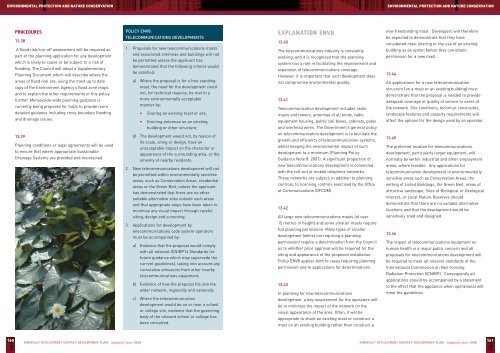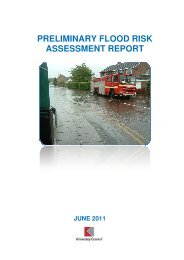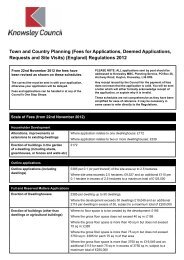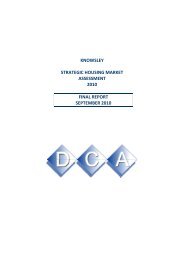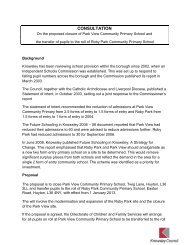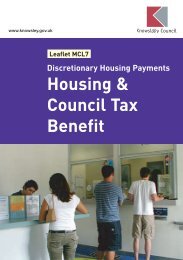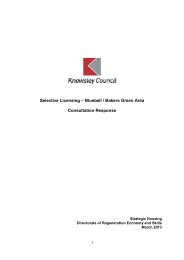Knowsley Replacement Unitary Development Plan - Knowsley Council
Knowsley Replacement Unitary Development Plan - Knowsley Council
Knowsley Replacement Unitary Development Plan - Knowsley Council
You also want an ePaper? Increase the reach of your titles
YUMPU automatically turns print PDFs into web optimized ePapers that Google loves.
ENVIRONMENTAL PROTECTION AND NATURE CONSERVATION<br />
ENVIRONMENTAL PROTECTION AND NATURE CONSERVATION<br />
PROCEDURES<br />
13.38<br />
A flood risk/run-off assessment will be required as<br />
part of the planning application for any development<br />
which is likely to cause or be subject to a risk of<br />
flooding. The <strong>Council</strong> will adopt a Supplementary<br />
<strong>Plan</strong>ning Document which will describe where the<br />
areas of flood risk are, using the most up to date<br />
copy of the Environment Agency’s flood zone maps<br />
and to explain the other requirements of this policy<br />
further. Merseyside-wide planning guidance is<br />
currently being prepared for SuDs to provide more<br />
detailed guidance including cross boundary flooding<br />
and drainage issues.<br />
13.39<br />
<strong>Plan</strong>ning conditions or legal agreements will be used<br />
to ensure that where appropriate Sustainable<br />
Drainage Systems are provided and maintained.<br />
POLICY ENV8:<br />
TELECOMMUNICATIONS DEVELOPMENTS<br />
1. Proposals for new telecommunications masts<br />
and associated antennae and buildings will not<br />
be permitted unless the applicant has<br />
demonstrated that the following criteria would<br />
be satisfied:<br />
a) Where the proposal is for a free standing<br />
mast, the need for the development could<br />
not, for technical reasons, be met in a<br />
more environmentally acceptable<br />
manner by:<br />
• Sharing an existing mast or site,<br />
• Erecting antennae on an existing<br />
building or other structure;<br />
b) The development would not, by reason of<br />
its scale, siting or design, have an<br />
unacceptable impact on the character or<br />
appearance of the surrounding area, or the<br />
amenity of nearby residents.<br />
2. New telecommunications development will not<br />
be permitted within environmentally sensitive<br />
areas, such as Conservation Areas, residential<br />
areas or the Green Belt, unless the applicant<br />
has demonstrated that there are no other<br />
suitable alternative sites outside such areas<br />
and that appropriate steps have been taken to<br />
minimise any visual impact through careful<br />
siting, design and screening.<br />
3. Applications for development by<br />
telecommunications code system operators<br />
must be accompanied by:<br />
a) Evidence that the proposal would comply<br />
with all relevant ICNIRP14 Standards (or<br />
future guidance which may supersede the<br />
current guidelines), taking into account any<br />
cumulative emissions from other nearby<br />
telecommunications equipment;<br />
b) Evidence of how the proposal fits into the<br />
wider network, regionally and nationally.<br />
c) Where the telecommunication<br />
development would be on or near a school<br />
or college site, evidence that the governing<br />
body of the relevant school or college has<br />
been consulted.<br />
EXPLANATION ENV8<br />
13.40<br />
The telecommunications industry is constantly<br />
evolving, and it is recognised that the planning<br />
system has a role in facilitating the improvement and<br />
expansion of telecommunications coverage.<br />
However, it is important that such development does<br />
not compromise environmental quality.<br />
13.41<br />
Telecommunication development includes radio<br />
masts and towers, antennae of all kinds, radio<br />
equipment housing, public call boxes, cabinets, poles<br />
and overhead wires. The Government’s general policy<br />
on telecommunication development is to facilitate the<br />
growth and efficiency of telecommunication systems,<br />
whilst keeping the environmental impact of such<br />
development to a minimum (<strong>Plan</strong>ning Policy<br />
Guidance Note 8: 2001). A significant proportion of<br />
new telecommunications development is connected<br />
with the roll-out of mobile telephone networks.<br />
These networks are subject, in addition to planning<br />
controls, to licensing controls exercised by the Office<br />
of Communications (OFCOM).<br />
13.42<br />
All large new telecommunications masts (of over<br />
15 metres in height) and some smaller masts require<br />
full planning permission. Many types of smaller<br />
development (whilst not requiring a planning<br />
permission) require a determination from the <strong>Council</strong><br />
as to whether prior approval will be required for the<br />
siting and appearance of the proposed installation.<br />
Policy ENV8 applies both to cases requiring planning<br />
permission and to applications for determinations.<br />
13.43<br />
In planning for new telecommunications<br />
development, a key requirement for the operators will<br />
be to minimise the impact of the network on the<br />
visual appearance of the area. Often, it will be<br />
appropriate to share an existing mast or construct a<br />
mast on an existing building rather than construct a<br />
new freestanding mast. Developers will therefore<br />
be expected to demonstrate that they have<br />
considered mast sharing or the use of an existing<br />
building as an option before they can obtain<br />
permission for a new mast.<br />
13.44<br />
All applications for a new telecommunication<br />
structure (on a mast or an existing building) must<br />
demonstrate that the proposal is needed to provide<br />
adequate coverage or quality of service to users of<br />
the network. Site conditions, technical constraints,<br />
landscape features and capacity requirements will<br />
affect the options for the design used by an operator.<br />
13.45<br />
The preferred location for telecommunications<br />
development, particularly larger equipment, will<br />
normally be within industrial and other employment<br />
areas, where feasible. Any applications for<br />
telecommunication development in environmentally<br />
sensitive areas such as Conservation Areas, the<br />
setting of Listed Buildings, the Green Belt, areas of<br />
attractive landscape, Sites of Biological or Geological<br />
interest, or Local Nature Reserves should<br />
demonstrate that there are no suitable alternative<br />
locations and that the development would be<br />
sensitively sited and designed.<br />
13.46<br />
The impact of telecommunications equipment on<br />
human health is a major public concern and all<br />
proposals for telecommunications development will<br />
be required to meet all relevant standards of the<br />
International Commission on Non-Ionizing<br />
Radiation Protection (ICNIRP). Consequently all<br />
applications should be accompanied by a statement<br />
to the effect that the appliance when operational will<br />
meet the guidelines.<br />
160<br />
KNOWSLEY REPLACEMENT UNITARY DEVELOPMENT PLAN: Adopted June 2006<br />
KNOWSLEY REPLACEMENT UNITARY DEVELOPMENT PLAN: Adopted June 2006<br />
161


